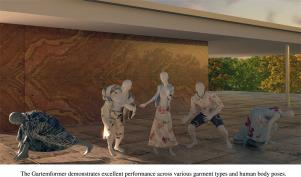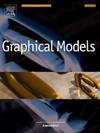GarTemFormer: Temporal transformer-based for optimizing virtual garment animation
IF 2.2
4区 计算机科学
Q2 COMPUTER SCIENCE, SOFTWARE ENGINEERING
引用次数: 0
Abstract
Virtual garment animation and deformation constitute a pivotal research direction in computer graphics, finding extensive applications in domains such as computer games, animation, and film. Traditional physics-based methods can simulate the physical characteristics of garments, such as elasticity and gravity, to generate realistic deformation effects. However, the computational complexity of such methods hinders real-time animation generation. Data-driven approaches, on the other hand, learn from existing garment deformation data, enabling rapid animation generation. Nevertheless, animations produced using this approach often lack realism, struggling to capture subtle variations in garment behavior. We proposes an approach that balances realism and speed, by considering both spatial and temporal dimensions, we leverage real-world videos to capture human motion and garment deformation, thereby producing more realistic animation effects. We address the complexity of spatiotemporal attention by aligning input features and calculating spatiotemporal attention at each spatial position in a batch-wise manner. For garment deformation, garment segmentation techniques are employed to extract garment templates from videos. Subsequently, leveraging our designed Transformer-based temporal framework, we capture the correlation between garment deformation and human body shape features, as well as frame-level dependencies. Furthermore, we utilize a feature fusion strategy to merge shape and motion features, addressing penetration issues between clothing and the human body through post-processing, thus generating collision-free garment deformation sequences. Qualitative and quantitative experiments demonstrate the superiority of our approach over existing methods, efficiently producing temporally coherent and realistic dynamic garment deformations.

GarTemFormer:基于时间变换器的虚拟服装动画优化工具
虚拟服装动画和变形是计算机图形学的一个重要研究方向,在计算机游戏、动画和电影等领域有着广泛的应用。传统的物理方法可以模拟服装的物理特性,如弹性和重力,从而产生逼真的变形效果。然而,此类方法的计算复杂性阻碍了动画的实时生成。另一方面,数据驱动方法可以从现有的服装变形数据中学习,从而快速生成动画。然而,使用这种方法生成的动画往往缺乏真实感,难以捕捉服装行为的细微变化。我们提出了一种兼顾逼真度和速度的方法,通过考虑空间和时间维度,我们利用真实世界的视频来捕捉人体运动和服装变形,从而制作出更逼真的动画效果。我们通过对齐输入特征和批量计算每个空间位置的时空注意力来解决时空注意力的复杂性。在服装变形方面,我们采用服装分割技术从视频中提取服装模板。随后,利用我们设计的基于变换器的时空框架,我们捕捉了服装变形与人体形状特征之间的相关性以及帧级依赖性。此外,我们还利用特征融合策略来合并形状和运动特征,通过后处理来解决服装与人体之间的穿透问题,从而生成无碰撞的服装变形序列。定性和定量实验证明了我们的方法优于现有方法,能有效生成时间上一致且逼真的动态服装变形。
本文章由计算机程序翻译,如有差异,请以英文原文为准。
求助全文
约1分钟内获得全文
求助全文
来源期刊

Graphical Models
工程技术-计算机:软件工程
CiteScore
3.60
自引率
5.90%
发文量
15
审稿时长
47 days
期刊介绍:
Graphical Models is recognized internationally as a highly rated, top tier journal and is focused on the creation, geometric processing, animation, and visualization of graphical models and on their applications in engineering, science, culture, and entertainment. GMOD provides its readers with thoroughly reviewed and carefully selected papers that disseminate exciting innovations, that teach rigorous theoretical foundations, that propose robust and efficient solutions, or that describe ambitious systems or applications in a variety of topics.
We invite papers in five categories: research (contributions of novel theoretical or practical approaches or solutions), survey (opinionated views of the state-of-the-art and challenges in a specific topic), system (the architecture and implementation details of an innovative architecture for a complete system that supports model/animation design, acquisition, analysis, visualization?), application (description of a novel application of know techniques and evaluation of its impact), or lecture (an elegant and inspiring perspective on previously published results that clarifies them and teaches them in a new way).
GMOD offers its authors an accelerated review, feedback from experts in the field, immediate online publication of accepted papers, no restriction on color and length (when justified by the content) in the online version, and a broad promotion of published papers. A prestigious group of editors selected from among the premier international researchers in their fields oversees the review process.
 求助内容:
求助内容: 应助结果提醒方式:
应助结果提醒方式:


